- Agentic AI vs. Generative AI
- 2025-08-06
Agentic AI vs. Generative AI: An Ultimate Guide for Decision Makers

Audio Track
Table of Contents
Key Takeaways:
- Generative AI creates content based on prompts provided, Agentic AI takes action, executes tasks, and makes decisions in real-time. This makes it more suitable for complex tasks.
- Examples of Gen AI include ChatGPT, DALL-E, GitHub Copilot, etc. Agentic AI examples include AutoGPT, Devin AI, ChatDev, and more.
- Gen AI remains limited to single-step outputs while Agentic AI offers multi-step reasoning and process automation, which is ideal for large-scale enterprise processes.
- Adopting Agentic AI across the enterprise is a paradigm shift that redefines how businesses operate, innovate, and scale.
What’s Driving the Buzz
When thinking of the term Artificial Intelligence (AI), images of robots and machines conjure up. AI is but a broad tree with branches reaching into every corner of modern technology. The new era of AI is emerging and it’s now stepping into the role of a decision-maker. This shift has sparked conversations around two robust technologies today: Generative AI and Agentic AI.
The debate around Agentic AI vs. Generative AI is more than just technical, it’s a question of: Agentic AI vs. Generative AI, which is better for enterprise automation? And as businesses weigh their options, understanding these differences is essential as we stand on the brink of new technological innovation.
But first let’s get an overall understanding of what is Agentic AI vs. Generative AI.
What is Generative AI?
Where most AI systems interpret, Generative AI imagines.
Generative AI or Gen AI is a type of Artificial Intelligence that can produce original content ideas, like images, videos, audios, texts, music, code, and stories. The recent breakthrough in the Generative AI field has the ability to change content creation.
AI has been the hot topic of the past, now Gen AI has entered space, specifically after the arrival of ChatGPT in 2022, has propelled AI into the headlines worldwide and initiated an unexpected increase in AI adoption and innovation.
Insights from McKinsey indicate, one-third of organizations are already leveraging Gen AI daily in one business function. Gartner projects that over 80% of companies will deploy Generative AI apps by 2026.
Core Capabilities of Generative AI
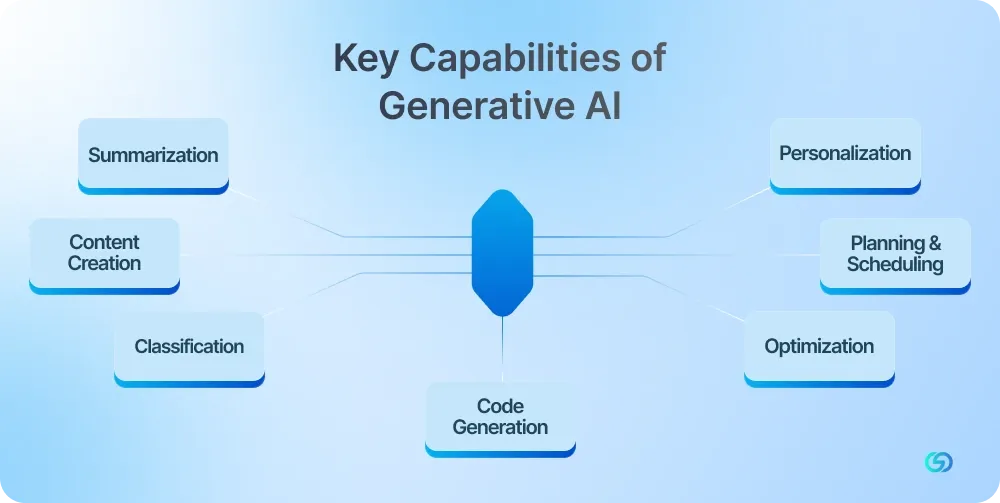
Gen AI has the capacity to revolutionize industries by combining creativity and intelligence. This advanced AI, powered by deep learning models has shown surprising capabilities in:
- Summarization: Gen AI leverages text summarization technique to tackle longstanding challenge of summarizing lengthy texts.
- Content Creation: Gen AI automates numerous types of content, from writing blog posts, stories, articles to generating artwork and composing songs. These models learn from patterns, styles, and structures by examining large amounts of data.
- Classification: Generative AI has enhanced accuracy by classifying primary tasks in ML. Gen AI LLMs can learn to classify different types of data based on their context.
- Personalization: Users are looking for personalization and it has become an important part of any service. Gen AI is capable of creating personalized content, recommendations, and experiences.
- Planning & Scheduling: With time management, resource allocation, and decision-making, Gen AI can help in planning and scheduling tasks.
- Optimization: Gen AI plays a crucial role in streamlining complex processes by examining large amounts of data, spotting patterns, and recommending optimal solutions. Optimization is crucial for many industries like logistics and manufacturing.
- Code Generation: Generative AI helps in software development by automatically producing code snippets and templates. This model generates code that aligns with coding standards and specific requirements.
Underlying Architecture of Generative AI
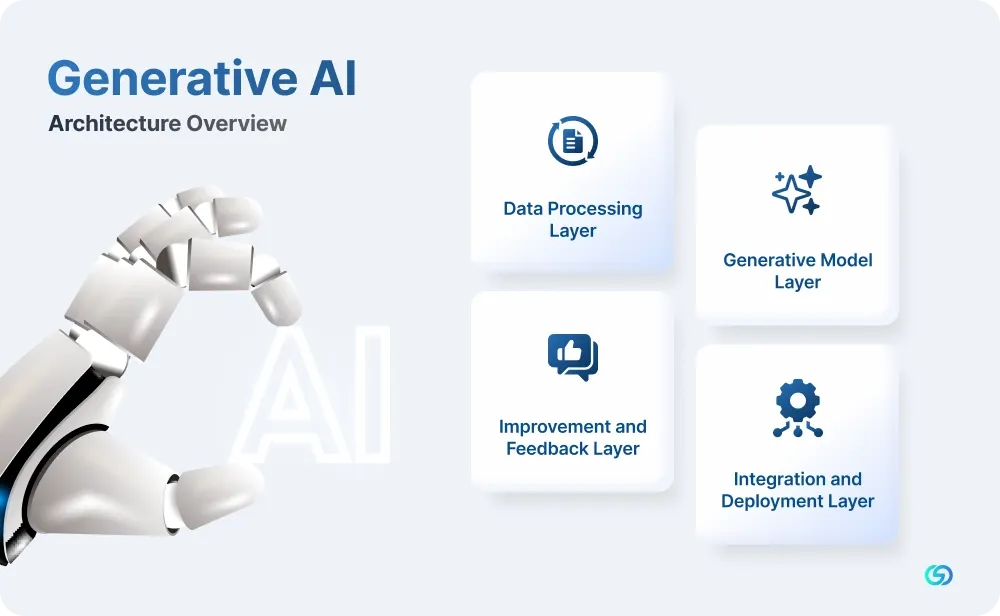
Generative AI architecture focuses on systems that create new content, involving several layers. Here’s a breakdown:
Data Processing Layer
This layer helps in cleaning and preparing large amounts of data required to train generative models. It can handle tasks like feature extraction and data normalization.
Generative Model Layer
This is the core architecture, containing the algorithms that learn patterns from data and produce new content. Some common models include GANs, LLMs, VAEs, Diffusion Models, and Transformers.
Improvement and Feedback Layer
This Gen AI layer focuses on monitoring the produced content and offering feedback to the model for constant improvement. This involves tracing performance metrics and fine-tuning the model with feedback or new data.
Integration and Deployment Layer
This model manages integration of the Gen AI model with other apps and systems. It involves tasks like Retrieval Augmented Generation (RAG), prompt engineering, and fine-tuning pipelines.
Why is Generative AI Important?
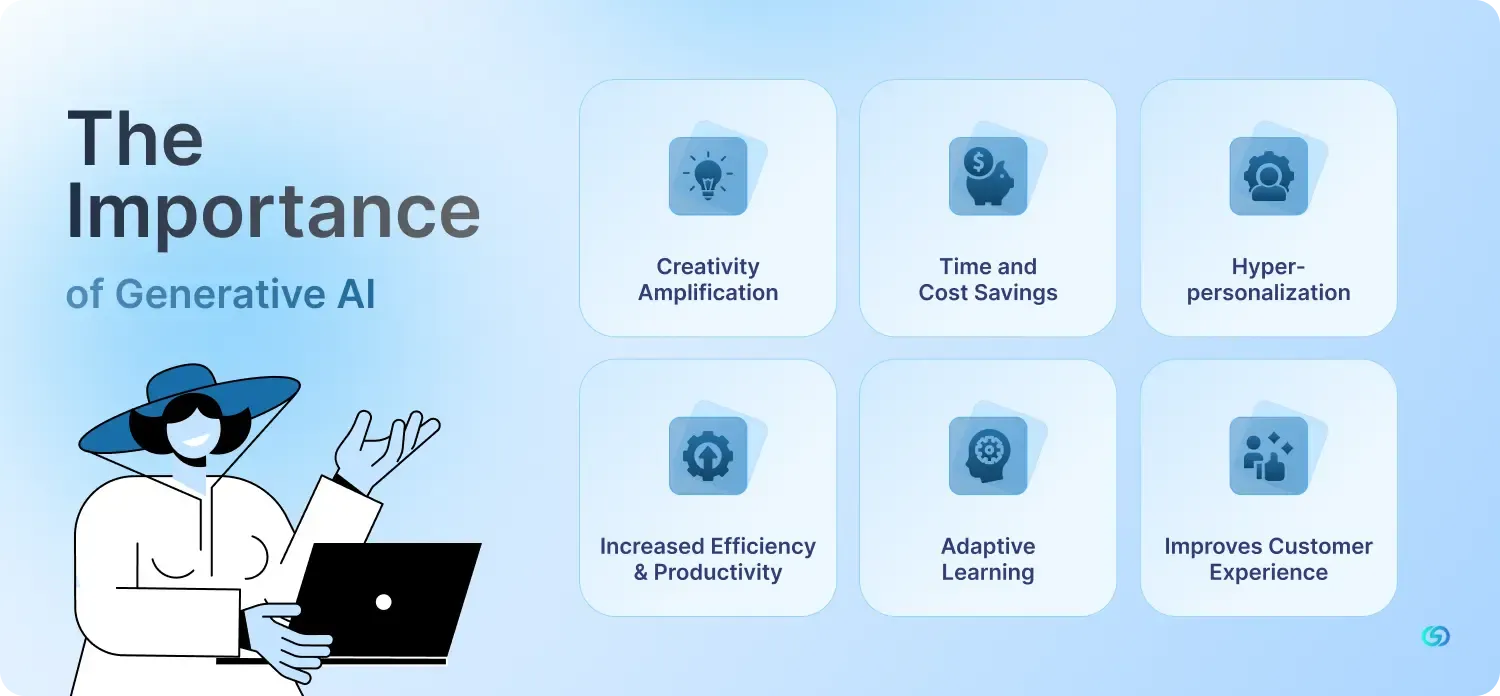
Now, let us dig deeper into the benefits offered by Generative AI.
Creativity Amplification: Gen AI allows businesses to produce engaging and creative content on a vast scale.
- Time and Cost Savings: By automating tasks, Gen AI saves valuable time and other operational costs.
- Hyper-personalization: Gen AI helps hyper-personalize the customer experience by examining customer data and giving personalized recommendations based on user preferences.
- Increased Efficiency & Productivity: Businesses can automate time-consuming and complex processes with Gen AI, which allows them to improve efficiency and streamline workflow.
- Adaptive Learning: Why is Gen AI important because it can constantly learn and adapt based on new data and feedback. This ability allows it to improve performance and produce outputs that align better with user preferences.
- Improves Customer Experience: Gen AI improves user experience with hyper-personalization, enhancing customer service efficiency, forecasting consumer needs, and improving customer retention.
As impressive as Generative AI is, there’s a new wave of AI coming, the one that doesn’t create but acts. It’s called Agentic AI. If Gen AI is the mind behind the masterpiece, Agentic AI is the doer—executing the task.
Generative AI is used widely in marketing content creation, creative writing, code generation, and customer support automation, assisting businesses to scale content and communicate effectively.
The conversation around Agentic vs. Generative AI is now gaining momentum, especially with the rise in the usage of Generative AI agents. Today, with technology changing every field it touches, the line between smart and independent agents is starting to blur.
What is Agentic AI?
Agentic AI is a type of Artificial Intelligence, running independently to build, execute, and streamline workflow. This allows businesses to make decisions more effectively and get the work done on time. Serving as a comprehensive system, Agentic AI allows seamless interactions with humans and AI agents and creating a collaborative environment.
Agentic AI is the next powerful AI model known for its capability to operate independently by smart making decisions, adapting to evolving situations, reasoning, and setting goals. The global Agentic AI market size was valued at approx. $2.58 billion in 2024 and is expected rise to $24.5 billion by 2030, growing at a notable CAGR of 46.2% between 2025 to 2030.
Core Capabilities of Agentic AI
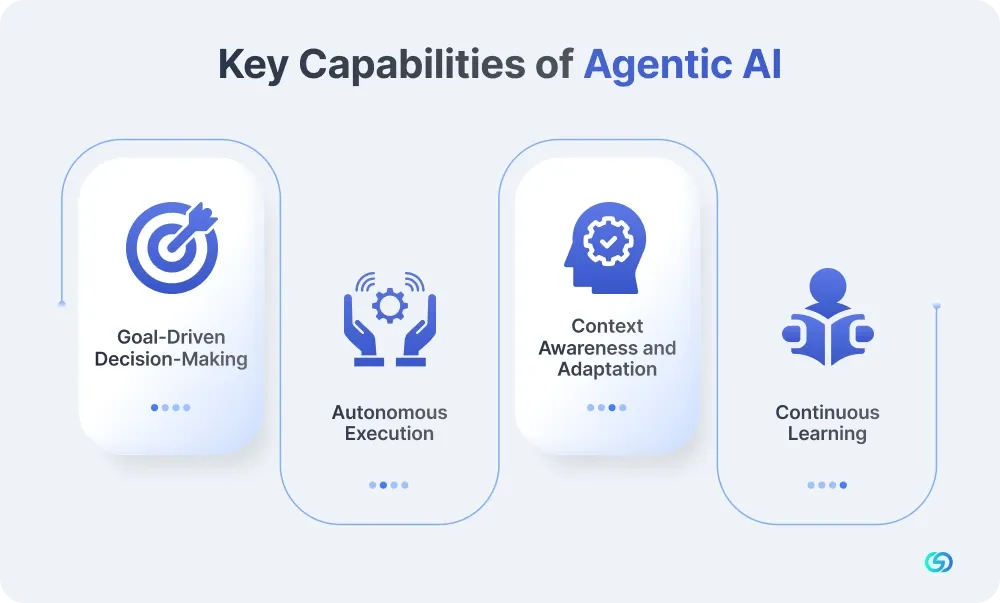
Agentic AI is measured by a set of core capabilities that allows them to operate effectively in complex environments.
- Goal-Driven Decision-Making: Agentic AI is about understanding goals and striving to achieve them. By analyzing various data and forecasting future outcomes, AI agents can autonomously determine the most effective course of action.
- Autonomous Execution: Agentic AI handles the execution phase without the need of step-by-step instructions. LangChain agents, an AI system can execute tasks by calling tools and taking smart decisions.
- Context Awareness and Adaptation: Context plays a significant role in decision-making and Agentic AI constantly tracks its environment to comprehend the context of the data they receive and adjust actions.
- Continuous Learning: Compared to traditional systems, Agentic AI is designed for continuous learning. It collects feedback, picks from new experiences, and refines its processes over time.
Why is Agentic AI Important?
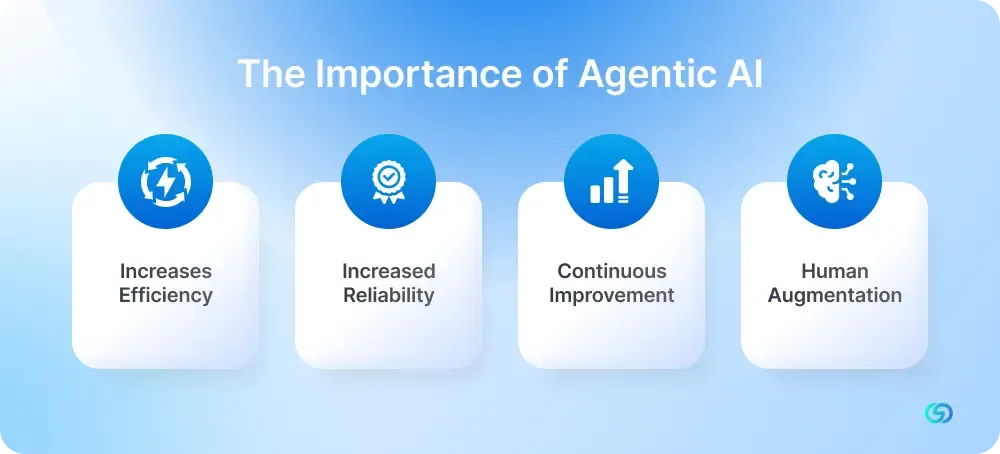
Agentic AI has created quite a buzz across several industries for bringing flexibility and versatility of LLMs.
- Increases Efficiency: Agentic AI takes efficiency to new heights by simplifying complex processes through automation. Using Agentic AI can automate repeated tasks, freeing up employees.
- Increased Reliability: Agentic AI offers hyper-personalization to customers. By leveraging customer data, this AI model can generate custom messaging, engage with users in their preferred style, and offer product recommendations.
- Continuous Improvement: By constantly improving and learning, Agentic AI can adapt to any task assigned to it. It learns from feedback and optimizes decision-making.
- Human Augmentation: Agentic AI serves as a collaboration tool for humans, boosting productivity and decreasing laborious manual tasks they need to complete.
Agentic AI vs. Generative AI examples highlight the difference between action and creation. Some of the most talked-about implementations of Agentic AI include AutoGPT, Devin AI, ChatDev, React pattern, LangChain agents. On the other hand, ChatGPT, Midjourney, and DALL-E are Generative AI tools focused on creating content based on prompts.
Agentic AI vs. Generative AI: Key Differences
Exploring the Agentic AI vs. Generative AI differences, it’s crucial to understand what modern technologies seek to attain and how it works. Following is the breakdown of the key distinction:
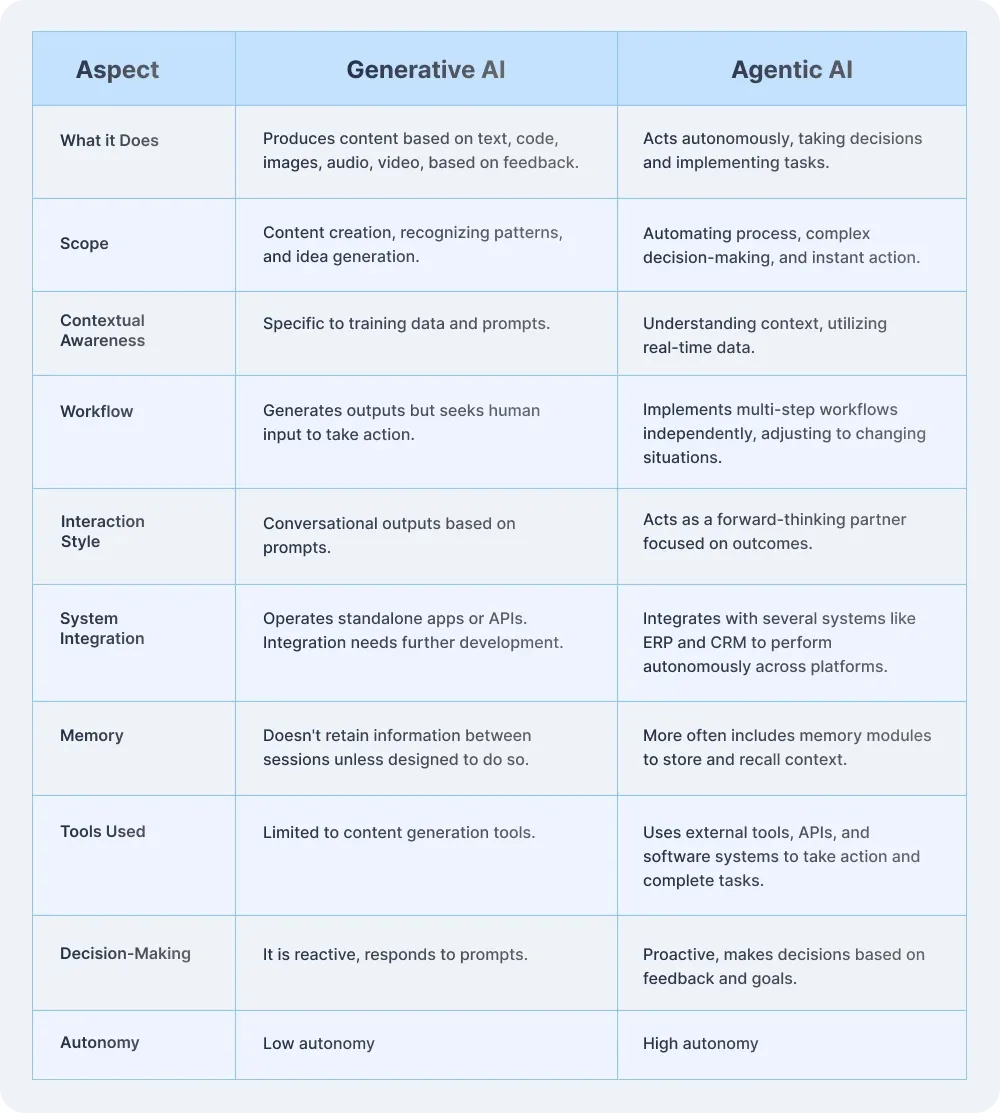
Real-World Use Cases of Generative AI & Agentic AI: When to Use Which?
Now that you have an understanding of Generative AI vs. Agentic AI, you already have an idea that these AI tools are not designed to replace human sight, experience, and judgement. These advanced tools save time and help professionals focus on what they do best.
Here are examples of important use cases for each AI:
Generative AI Use Cases
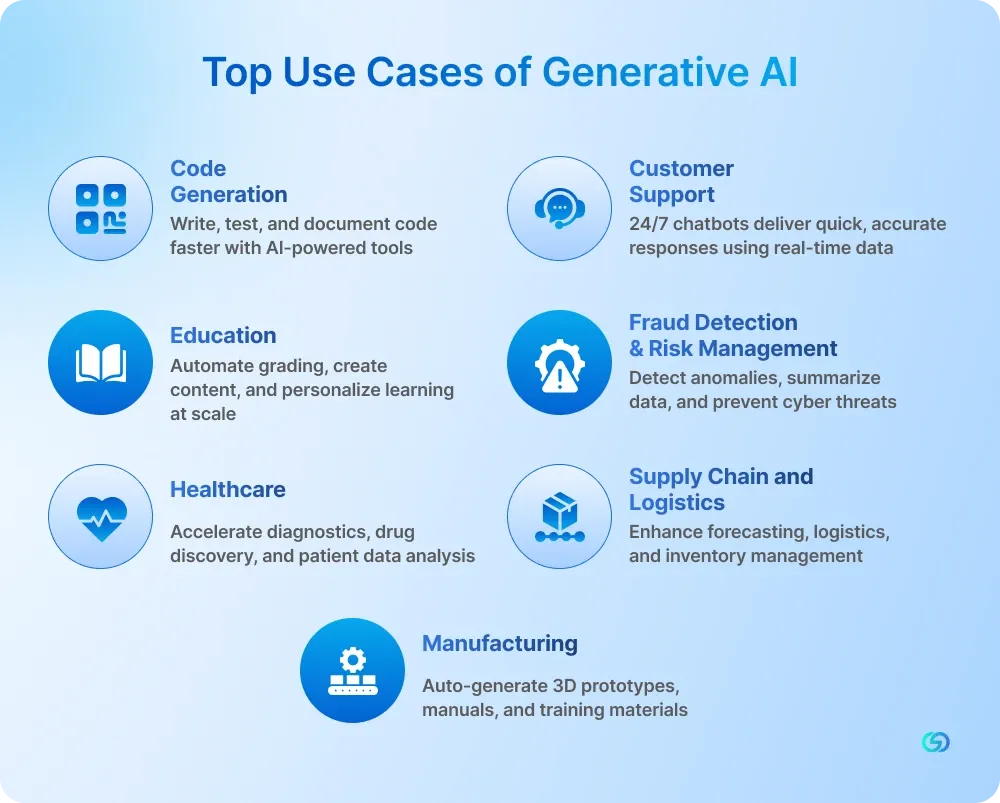
Several industries across the world have infused Generative AI into their existing system. Those systems relying on high volumes of designed and written content, find Gen AI has a matchless asset.
- Code Generation: Developers use Gen AI to write, maintain code, and test apps during the development phase. AI coding tools handle bug fixes and several documentation types that a coder might need.
- Customer Support and Service: AI-based chatbots and virtual assistants process large amounts of data to accurately answer customers. They offer around-the-clock support and deliver quick responses.
- Education: AI-powered content generation, tutoring, and automated grading are becoming popular. Gen AI helps educators in providing personalized learning experiences and automating administrative tasks.
- Fraud Detection & Risk Management: Gen AI scans and summarizes vast data, identifies anomalies, and helps underwriters. It generates tailored insights, prevents cyberthreats, and false transactions.
- Healthcare: Gen AI is revolutionizing life sciences by helping with patient engagement, drug discovery, and diagnostics. AI tools summarize patient histories, medical records, and lab results.
- Supply Chain: Gen AI is changing supply chain management, operational efficiency, and workflows by improving logistics, demand forecasting, and inventory management.
- Manufacturing: Generative AI designs product prototypes by generating 3D models on constraints and specifications. It also creates maintenance manuals and training content automatically, speeding up production workflows.
Agentic AI Use Cases

With the help of Agentic AI, experts and industry leaders deliver value across diverse industries with smart decision-making and automating daily tasks.
Let’s look at Agentic AI applications:
- Code Generation: Agentic AI in code generation goes beyond just producing code snippets. It involves autonomous systems that understand requirements, generate, review, plan, debug, and refine code.
- Call Centers: Unlike traditional AI, Agentic AI has improved and proved its efficiency in call centers by orchestrating automation and intelligence across several activities while serving customers.
- Supply Chain and Logistics: The Agentic AI application extends to the supply chain and logistics industry as well, handling several tasks at a time. For instance, if a drought hits a region, affecting the cost of produce and availability, Agentic AI can quickly find and deliver the required supplies at the lowest cost.
- Education: Agentic AI offers personalized tutoring, adapting to student's learning styles, immediate feedback, and autonomous grading, which frees up tutor's time, leading to better operational efficiency.
- Healthcare: Agentic AI uses intelligent systems to offer personalized patient care, optimize hospital workflow, and enhance decision-making in clinics. This leads to better patient outcomes.
- Fraud Detection: Agentic AI investigates anomalies in real-time. For example, it detects unusual transaction patterns, and AI agents pause the transaction, analyze user behavior across system, and resolve the issue autonomously all without human intervention.
- Manufacturing: In the manufacturing industry, Agentic AI assists extensively by taking smart decisions and autonomous actions, which help encompass several functions and IT systems.
Agentic AI vs. Generative AI Examples
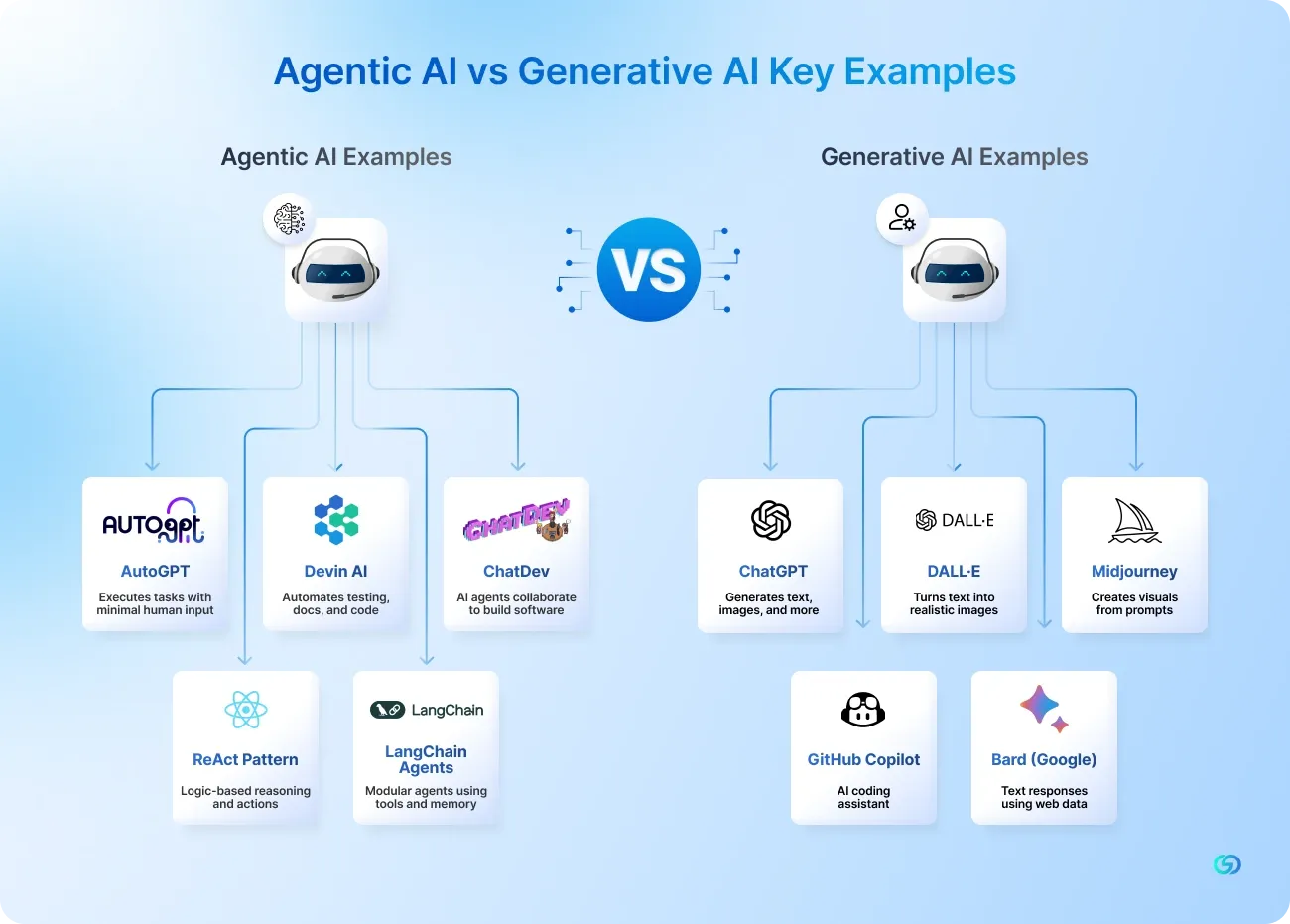
Agentic AI focuses on autonomous decision-making in dynamic environment while Generative AI creates new content, and examples of both exists in various industries.
Agentic AI Examples:
- AutoGPT: A powerful platform tool that runs AI assistants to perform tasks automatically on your behalf with minimal human input.
- Devin AI: Automates repetitive tasks like testing, documentation, and code generation, freeing up developers to focus on complex issues.
- ChatDev: A platform where multiple AI agents collaborate in roles like CTO, CEO, and developer to build software.
- ReAct Pattern: It’s a reasoning framework that allows AI agents to think and act using logic and action.
- LangChain Agents: Modular AI agents, using tools, memory, and external data to complete complex tasks.
Generative AI Examples:
- ChatGPT: This Gen AI chatbot generates text, images, speech, and videos in response to prompts.
- DALL-E: Creates realistic images and art from text description.
- Midjourney: An image generator that converts prompts into artistic visuals.
- GitHub Copilot: AI coding assistant, helping you write code with less effort.
- Bard (by Google): A conversational AI that produces text-based responses using web-integrated knowledge.
AI Agents vs. Generators: How Are They Different?
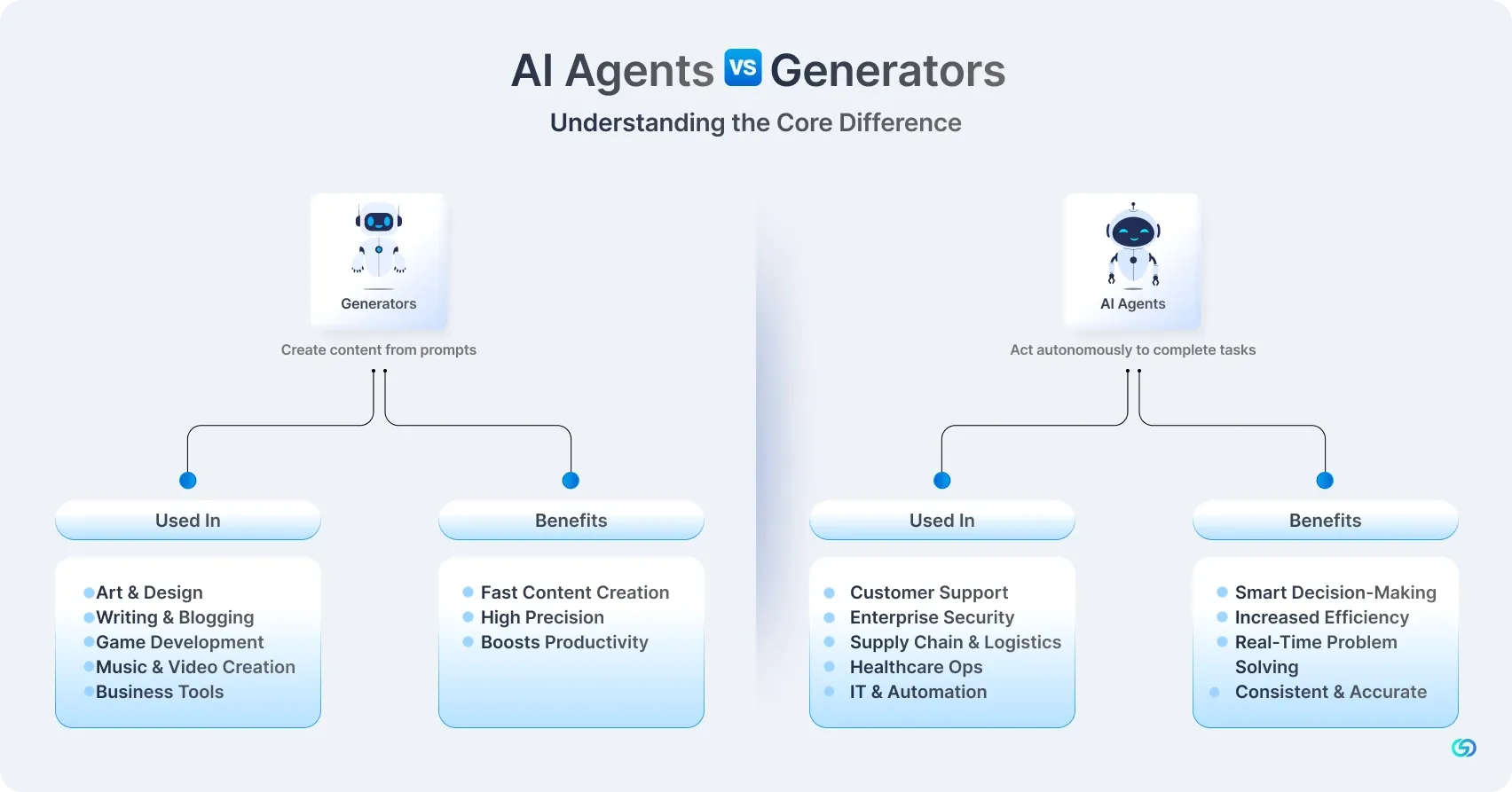
Let’s understand AI agents and AI generators to have a basic understanding and difference between the two so that the concept doesn’t overlap.
What is an AI Generator?
Tools that leverage AI technology to generate specific content are known as AI Generator. They are an innovative way to assist content creation in various domains such as images, texts, videos, and music. Offering valuable support to the creators with just a prompt, AI Generators can produce original texts, music, artwork, and more in seconds.
As AI continues to progress, all fields are constantly improving and enhancing. Leveraging these generators has become a crucial exploration in several industries and domains.
💠Fields AI Generators Can Be Applied:
- Cultural and Artistic
- Game Development
- Architectural Design
- Business Applications
- Publishing & Blogging
💠Advantages of AI Generators:
- Improve Efficiency
- High Precision
- Increased Productivity
What are AI Agents?
AI agents are a type of AI system that can study and respond to customer queries without human intervention. These agents are created using agent builder, like Machine Learning, Agentforce, and NLP to manage various tasks. The agents can include anything from resolving complex issues to answering questions. Additionally, they can improve their performance through self-learning.
💠Fields AI Agents Can Be Applied:
- Enterprise Security
- Customer Experience
- Supply Chain & Logistics
- Healthcare Operations
- IT Operations
💠Advantages of AI Agents:
- Increased Efficiency
- Improved Customer Satisfaction
- Improved Decision Making
- Data-Driven Insights
- Accuracy and Consistency
Predictive AI vs. Generative AI vs. Agentic AI
Want to clarify the various types of AI? Here’s a simple table comparing Predictive AI vs. Generative AI vs. Agentic AI based on their core functions:
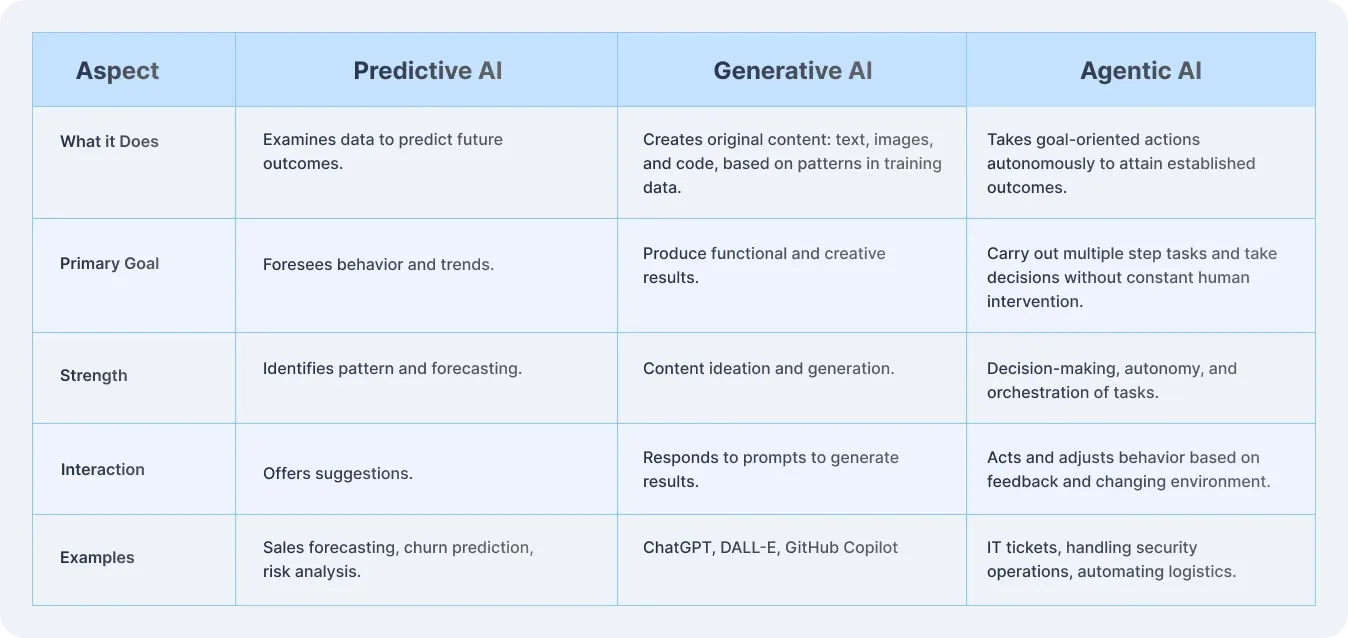
Is Agentic AI the Evolution of Generative AI?
In the ever-evolving world of technology, AI has undergone tremendous transformation. Once what was limited to following guidelines and rules and producing results on command has now changed to AI that not only generates content but makes decisions, takes initiatives, and acts independently. This transformation marks a major shift from Generative AI to Agentic AI.
Understanding this shift is crucial for anyone working in technology, innovation, and business.
Think of this like, Generative AI crafts a plan to improve your customer support system. While Agentic AI creates the plan, raises the ticket, reallocates CRM resources, and updates your team with results. This change from passive thinker to an active doer is an evolution for Generative AI to Agentic AI.
Challenges and Limitations of Generative AI and Agentic AI
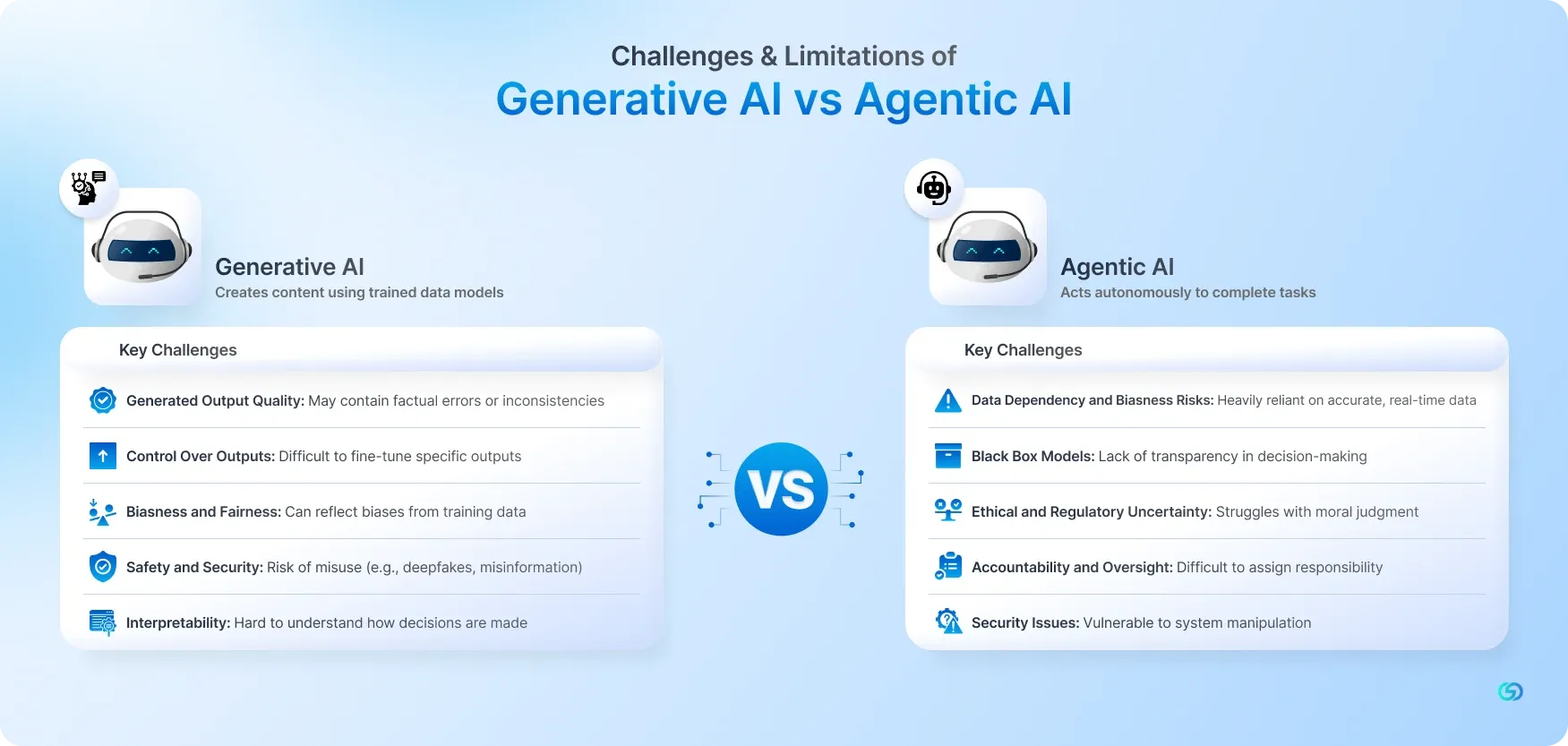
Let’s dig into the limitations and challenges of Generative AI and Agentic AI, while the potential is enormous, it is not without roadblocks.
Generative AI Challenges & Limitations
1️⃣ Generated Output Quality
Gen AI may not always produce quality results and may contain factual errors. This could be due to lack of data, complex models, and poor training.
To overcome this, experts can use advanced models that capture the underlying patterns and train on diverse datasets.
2️⃣ Control Over Outputs
Gen AI is trained on datasets and can produce new results that are similar but not identical to the input data. But it can be tough to control the specific characteristics of the outputs.
To gain more control, researchers can leverage conditional VAEs and GANs, allowing the model to generate results based on specified conditions.
3️⃣ Biasness and Fairness
This AI model may mirror biases found in the training data. This can lead to unfair results.
To address this issue, experts can use debiasing learning, which helps in eliminating biases in the training data.
4️⃣ Safety and Security
Generative AI can be utilized to produce fake yet realistic images, texts, videos, and more, which can be used to spread false information.
To ensure safety and security, experts can use adversarial training and robust optimization techniques to make the model resistant to attack.
5️⃣ Interpretability
Gen AI can be complex, making it tough to understand how they are making predictions. This is a challenge when trying to ensure the model is making unbiased decisions.
To improve this, professionals can use visualization and model interpretability techniques to understand predictions that are being made.
Agentic AI Challenges and Limitations
1️⃣ Data Dependency and Biasness Risks
Agentic AI is trusted for its diverse, high-quality, and updated data. Any lack in the pipelines can lead to inaccuracies, bias, and errors in decision-making.
This makes the RPA experts treat data management as a crucial aspect in automation.
2️⃣ Black Box Models
Several systems powered by LLM operate as black boxes, which makes it difficult to interpret how decisions are made. This transparency can pose compliance risks.
Transparency tools need to evolve alongside Agentic AI; businesses should demand accountability from their AI vendors.
3️⃣ Ethical and Regulatory Uncertainty
Agentic AI works on pre-defined rules and logic, however, lacks the ethical judgment needed to handle morally complex situations.
As RPA evolved with lifecycle management tools to maintain consistency, Agentic AI must now evolve by embedding ethical guardrails that align its decisions with human values.
4️⃣ Accountability and Oversight
Agentic AI’s increased autonomy raises accountability problems; the main challenge lies in the complexity of assigning responsibility when an AI agent causes harm. Unlike traditional RPA, where results are predictable, Agentic AI introduces unpredictability that complicates governance.
RPA systems have rules in place to monitor bot activities and maintain audit records. Similarly, AI systems need clear guidelines and action tracking to ensure accountability when something goes wrong.
5️⃣ Security Issues
Due to the enhanced autonomy of Agentic AI, it has become an attractive target for harmful activities. Decision-making may alter due to a manipulated system.
Cybersecurity practices need to grow along with AI deployment. The way RPA platforms emphasize encryption and compliance, similar controls should protect AI systems.
Agentic AI vs. Generative AI: Which is Better for Enterprise Automation?
Now that you have an idea what is Agentic AI vs Generative AI, it is easier to understand what will fit your business right.
Most progressive enterprises benefit from a hybrid approach, leveraging Generative AI as well as Agentic AI. Gen AI is used for creating content and brainstorming, while the latter is used for task execution and streamlining processes.
Gen AI is great at drafting ideas, while Agentic AI acts like a proactive manager, focused on getting things done, coming with a goal-driven perspective.
So, what fits best for enterprise solution? Do you prefer scaling creative output or aiming to automate tasks?
Before implementation, evaluate:
- Your team’s workflow
- Decision-making bottlenecks
- Need for content generation vs. operational automation
- Integration capabilities with your existing tech stack
Whatever option you go for, make sure it aligns with your everyday as well as long-term digital solutions.
Future of AI Models: The Road Ahead for Agentic AI vs. Generative AI
Agentic AI vs. Generative AI differences represent fundamentally different approaches of how AI can serve businesses. While many businesses know that AI will be the center of their future operations, there’s often a gap between acknowledging its significance and implementing AI strategies backed by ROI metrics and employee training programs. This gap creates a risk in the rapidly evolving tech landscape of today, especially in organizations that recognize the potential of AI but fail to leverage them.
To stay competitive, businesses need to invest in actionable strategies, by identifying where Gen AI can boost creativity and where Agentic AI can enhance execution and decision-making.
The future doesn’t belong to companies that merely integrate AI, but to those who do it with purpose and clarity. Several companies today are blending both models that handle everything.
Whether you are ready or not, this shift is underway.
Final Thoughts
Building Gen AI and Agentic AI or discovering their potential? Now that you understand the core Generative AI vs. Agentic AI difference, you know for sure that these technologies not only throw light on our present ecosystem but lays the groundwork for innovations in the future that will redefine how we collaborate with machines.
Whether you are building a multi-agent system or enhancing a single process with AI, ConvexSol helps you do it right. We build tailored Agentic AI solutions that act like your virtual partner, giving you the flexibility to develop, scale, and move fast, aligning every AI initiative with your KPIs.
Frequently Asked Questions
In what industries is Agentic AI particularly valuable?
Agentic AI is particularly valuable in industries, including supply chain management, healthcare, finance, customer support and retail, and manufacturing, where it can examine data and execute tasks autonomously. Major companies expect Agentic AI to transform enterprise decisions and workflow by 2028.
Are there emerging examples or incidents involving Agentic AI?
Yes. Agentic AI empowers businesses to become more efficient and proactive, resolving challenges before they escalate.
- In IT, it improves VPN troubleshooting, incident submissions, software testing, and more.
- In financial services, it autonomously monitors saving goals, investment strategies, and detects fraud by monitoring transaction patterns instantly.
- In HR, it automates tasks like CV screening and interview scheduling.
- In security, it monitors network traffic, detects suspicious activities, and triggers automated responses.
- In customer service, Agentic AI chatbots give answers to common questions in real-time without the need of a representative.
Which AI should I choose for my business: Generative or Agentic?
Agentic AI vs. Generative AI, which is better for enterprise automation, has become the talk of the town. Gen AI has revolutionized diverse industries with content creation and brainstorming. While, Agentic AI is a more self-reliant tool for making decisions, carrying out our interactions and multi-step activities. Choosing between the two depends on your business priorities. Many forward-thinking companies are integrating both Gen AI and Agentic AI, a powerful combination.
Can Generative AI and Agentic AI work together?
Yes, Generative AI and Agentic AI can work together as they are complementary technologies that enhances AI processes by combining their power. Generative AI offers creative content while Agentic AI handles reasoning, execution, and decision-making. Their synergy leads to increased efficiency, human-like interactions, and enhanced functionality.
Which AI is better for automation: Agentic or Generative?
Agentic AI is better for automation as compared to Gen AI. While Generative AI focuses on content creation, like texts, images, videos, and audios, Agentic AI acts independently without human input. It can plan, adapt, and make decisions, which proves to be ideal for automating workflows, handling repetitive processes, and overseeing operations.

